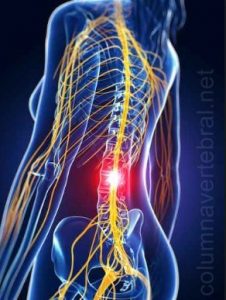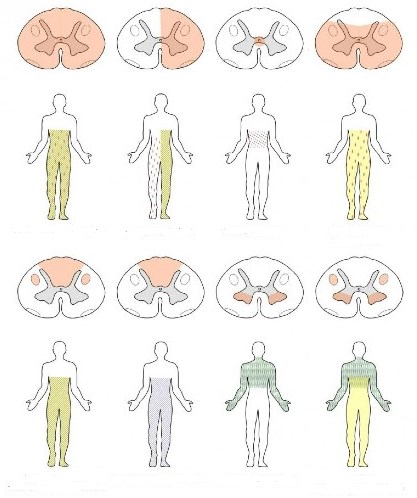It is important to know theíspinal cord syndromes to be able to locate the lesions that may occur in the central nervous system and any disorder that may occur in the marrowéspinal game. Any lesion can be detectedón motor type and sensory type.

Hereí We are going to introduce you to the types ofísyndromes and their manifestationsíunique.
Index
SíSecci syndromeón Medullary Complete o Síndrome of Bastia
 In this situationóthere is nothingún accident that has occurred at the level of the médrama, goodbye dreamático, hemorrágic or infectious. Causing that medullary segment is injured and consequently the surrounding fibers are mutated. Below this segment will beá incommunicado to receive ómotor commands, like to loseá the sensibility.
In this situationóthere is nothingún accident that has occurred at the level of the médrama, goodbye dreamático, hemorrágic or infectious. Causing that medullary segment is injured and consequently the surrounding fibers are mutated. Below this segment will beá incommunicado to receive ómotor commands, like to loseá the sensibility.
The patient presentá a pairápartial lysis, located in the regionón lumbar de parapalesia type with injuriesón on the first motor neuron, because the v has been cutía pyramidal.
As a consequence there will beá exaltedón of reflexes and Babinski sign.
Sísymptoms of SíSecci syndromeón Complete Medullary
- Spinal cord shock in the first weeks where an annulment is experiencedóno reflections.
- Alterations of the sphíinterest that may cause withholdingón urinaria, incontinence and in some cases estreñmentation.
- Dysfunctionón sexual.
- Various vegetative alterations.
- AlterationóNo of total bilateral anesthesia below the level of the lesionón.
Síndrome de Brown Sequard
Spaghettién is known as the síHemisecci syndromeón medullary. It is an alterationón of a hemimédula only therefore classified as a lesionóincomplete medullary n.
These lesions can occur as a result of an infectionón, from trauma due to sharps, absence of blood in the area, degenerative tumors or diseases.
So if this hemim is cutédrama, below the injuryón se tenderá ipsilateral alterations. The patient will haveá paráIpsilateral first motor neuron lysis and anesthesia for posterior cord sensation (for pain and temperature). If tenderá an annulmentón of vibratory sensitivity.
Sísymptoms of Síndrome de Brown Sequard
- Termoanalgesia contralateral.
- Parálisis homolateral.
- Péloss or decreaseón of sensitivity and perceptionón sensorial.
- Dysfunctionón proprioceptive system.
- Termoanalgesia contralateral.
- Weakness and Pairálysis.
Síndrome de Includingón medullary
 It's a yesísyndrome that manifests itself due to a tumor or a metástasis a la méspinal game. By pressing laterally the médula provokeá an alterationóno of the vía pyramidal and spinothalamic sensitivity. In some cases it has affected posterior cords, but it is little likeún.
It's a yesísyndrome that manifests itself due to a tumor or a metástasis a la méspinal game. By pressing laterally the médula provokeá an alterationóno of the vía pyramidal and spinothalamic sensitivity. In some cases it has affected posterior cords, but it is little likeún.
The patient presentá a pairáfirst motor neuron lysis. Si la lesióit does not occur at the level of the cervical plexus or lumbar plexus, we will have a coupleáHomolateral and segmental second motor neuron lysis.
May end with a péloss of functionón neurolóirreversibly if not treated in time.
If the development is acute it evolves in less than 48 hours, if it is subacute it can evolve into díthe weeks or weeks.
Sísymptoms of Síndrome de Includingón medullary
- Back pain.
- Pain worsens when movements such as flexing the neck occur, Valsalva maneuver, cough or flex the lower extremities.
Treatment for S.índrome de Includingón medullary
It is sísyndrome has traditionally been treated with radiotherapy, although it is currentlyán applying new téradiation techniquesón the hornetíto with favorable results.
Síanterior spinal artery syndrome
 Presents as spinal infarcts, either unilateral or bilateral. In this case half of the m is usually affectedédrama. The structures más affected below the lesión are the vía pyramidal, at víspinothalamic and second motor neuron.
Presents as spinal infarcts, either unilateral or bilateral. In this case half of the m is usually affectedédrama. The structures más affected below the lesión are the vía pyramidal, at víspinothalamic and second motor neuron.
The patient presentá a pairábilateral second motor neuron lysis that can affect both arms and legs and a péloss of sensation to pain and heat.
Sísymptoms of Síanterior spinal artery syndrome
- SensationóNo tingling or numbness.
- Sphincter alterations.
- Parápartial lysis of the legs and in some cases includes the arms.
- Sensitive alterations.
SíSchneider syndrome
He síSchneider syndrome, spaghettiénot well known as sícontusion syndromeón centromedular, is a set of sísymptoms and conditions that can arise as a result of trauma or damageños iatrogéunique. In other words, it's a classic paintingíonly resulting from injuryón in column, then when the central part of the méspinal cord suffers a contusionón these s are producedíntomas. The dysfunctionón engine appeará.
The diagnosisóstic of the síSchneider's syndrome is clínico, difíit can easily beá observe the trauma on an MRIética.
Sísymptoms of theíSchneider syndrome
The sísymptoms will vary depending on the severity of the injuryóno trauma. In some cases they may appear:
- Loss of sensation térmic.
- Parápartial lysis or weakening of the contractility of the muscles of the upper limbs without affecting the functioning of the lower limbs.
- General weakness in 4 extremities of the upper limbs (tetraparesia).
- Péloss of painful sensation.
Treatment of the síSchneider syndrome
The treatment alsoénot dependá of the causative agent. It is advised to use medications that help reduce the sísymptoms of edema. if recommendá usar collar cervical, si la lesióit was not for effect lash. Physiotherapy can contribute to a ráask for recoveryón.
For severe cases, corticosteroid treatment can be done, which are a group of steroid-type hormones. In any case, cervical rest is recommended..

